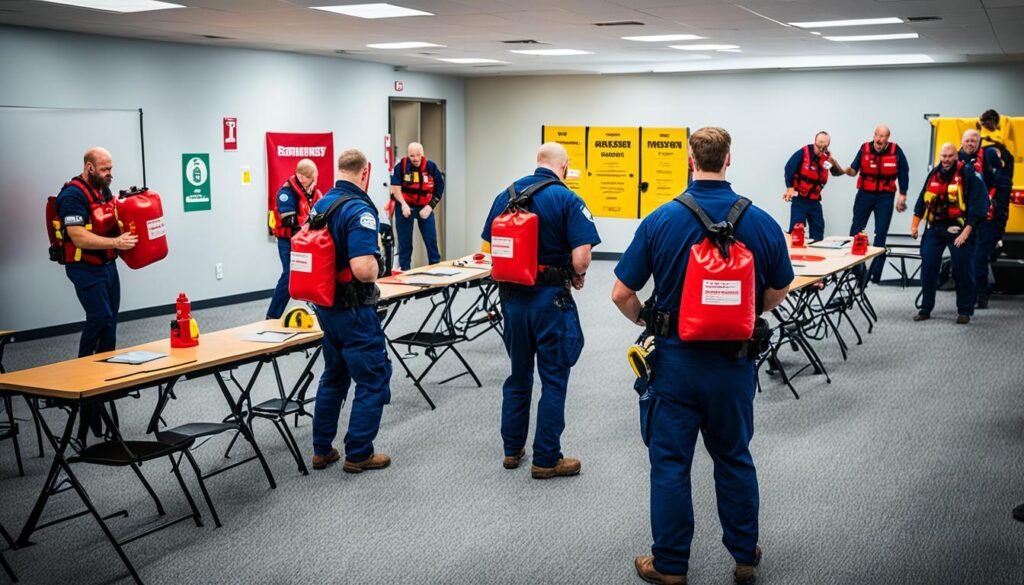In the U.S., businesses lose around $300 billion each year due to natural disasters and other emergencies. Keeping your employees safe and your operations running during these times is essential for your business’s success.
Training is key to preparing your workforce for emergency situations. Through emergency response training, your employees will learn how to handle crises. This helps them protect themselves and others.
During training, employees learn about evacuation and how to shelter in place. It’s important to have regular drills and exercises. These help check if emergency plans work and if your staff can do their roles well.
Teams that handle emergencies, business continuity, and crisis communication need extra training. Giving team leaders advanced training, like incident command system training, helps them lead better during emergencies.
Training should also cover first aid, CPR, and how to use AEDs and firefighting gear. If your employees use firefighting equipment or deal with hazardous materials, following OSHA rules is a must.
It’s important to keep records of all training sessions, who attended, and who taught them. This helps you know if the training works and if you’re meeting regulations.
Key Takeaways:
- Training is crucial for emergency response readiness to protect employees and ensure business continuity.
- Employees should be trained on various protective actions and their assigned roles and responsibilities.
- Specialized training for emergency response, business continuity, and crisis communications teams enhances their effectiveness.
- First aid, CPR, AED usage, and firefighting equipment operation skills should be provided as necessary.
- Compliance with OSHA regulations is essential when using firefighting equipment or responding to hazardous materials spills.
Benefits of Emergency Response Training
Emergency response training is key for employees and organizations. It arms them with skills and knowledge for emergency situations. This goes beyond just meeting compliance.
This type of training lets responders follow emergency protocols with confidence. This reduces injuries and saves lives. It keeps employees and the public safe.
Training improves response times. It helps responders quickly assess and act during emergencies. This leads to less damage and loss.
It also boosts responder confidence. With training, individuals know what to do and stay calm. This increases the success of handling emergencies.
Moreover, training teaches how to use safety resources right. From fire extinguishers to safety gear, responders learn to reduce risks. This makes everyone safer.
Offering this training shows a company’s care for its workers. It’s about more than safety; it’s about employee growth and well-being. Employees feel valued, leading to loyalty and higher productivity.
“Emergency response training equips individuals with the skills and confidence needed to effectively handle emergency situations while also fostering employee loyalty and long-term commitment.” – Emergency Response Expert
Emergency response training is vital for safety and smart for business. It helps organizations prepare for emergencies. This training creates a culture of readiness, making employees more confident and efficient.
| Benefits of Emergency Response Training |
|---|
| Reduces physical injuries and potential fatalities |
| Improves response time |
| Enhances responder confidence |
| Empowers effective utilization of safety resources |
| Fosters employee retention and loyalty |
The Role of Education in Disaster Preparedness
Educating people and communities is key in disaster readiness. It helps them know about risks and how to deal with them properly. Through education, especially for those at high risk, everyone can learn how to protect themselves better.
Being informed changes how people see dangers. Knowing what could happen, they can choose how to act when disaster strikes. This knowledge helps them put safety first and have good emergency plans ready.
Working together also boosts how well education and research work for disaster safety. By joining forces with groups like government bodies, charities, and schools, communities gain access to various skills and info. These efforts make disaster preparation better because everyone brings something important to the table.
In short, education is essential for being ready for disasters. It spreads important information, raises awareness, and encourages teamwork. All these make our communities stronger and more prepared to tackle crises caused by natural events or other emergencies.
Conclusion
An effective emergency response plan combines training, education, and ways to reduce risk. Organizations give comprehensive training to prepare employees for emergencies. They learn the protocols well. This training makes response times faster. It also builds responder confidence. This means they can use safety resources better and save lives.
Yet, training by itself isn’t enough. Education is key for being ready for disasters. It helps people understand the risks and how to lower them. Education programs teach individuals and communities about their weak spots. This way, they can act to lessen disaster impacts. Building community partnerships and using different fields of knowledge improves preparedness too.
To truly be ready for emergencies, organizations need a mix of training, education, and reducing risks. This means making and updating emergency plans often. It also means continuous training for staff. Plus, they must always check and manage the risks they face. When preparedness is a top priority and the necessary resources are put in, organizations can limit the damage of emergencies. They keep their employees and stakeholders safe.


